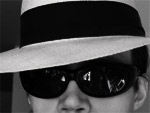Pizza, The OR and a Skull Series

Week of: 2007-07-23
Abstract: Pizza, The OR and a Skull Series.
Mood: Happy
What went well: I showed a high level of independence.
What needs work: Speed and accuracy in moving in and out and centering on the affected part with the C-arm
Elucidation: Monday was a slow starter but ended big. Early on a spent I lot of time sitting around in the dispatch office waiting for exams to come up. I thought I was going to do a Lap Chole, but the docs didn't request a C-arm for the procedure. I was somewhat disappointed because I wanted to comp it but I know it will come up soon. I waited most of morning for this exam so it was a waste of time. I made up for it by doing a wrist.
Later, I had the good fortune of participating in an exam that was termed speed surgery. The surgeons inserted the plate quickly due to the poor health of the patient (although cram would be a better descriptive verb.) It was interesting because the team worked like thieves in the night: quickly drilling holes and turning screws around the shattered portion of the femur. The patient's EKG demonstrated a very irregular heart beat, often slowing to the point of stopping for a count or two. The anesthesiologist was working constantly at a fevered pace to stabilize the patient, pushing drugs into the IV. The surgeons began closing before they had even put in 60% of the screws, something you don't see everyday.
Other days were rewarding on many counts as I showed a high level of independence. I was assigned a tibial plateau reduction and reconstruction. The patient's proximal tibia was in pieces. The axial MR images showed the pathology plainly. I observed as the surgeons placed plates in the medial, lateral and anterior aspects. I provided the images for the placement and anchoring of the hardware. The surgery stretched from 08:30-14:00. It was a nice step for me because I did it solo.
On Tuesday, The education coordinator celebrated our transition to second year status. By ordering two large pizzas and watching us stuff our faces. We got to leave early: bonus!
I witnessed a distal ulnar dislocation from the carpals. It clearly projected at right angle and one could see the articular cartilage after the part had been dissected. It was challenging for me because I was moving the C-arm base a lot. The tech observing me noted, "We need you to build some strength." He's right, I'm the 170 pound, under-muscled tall dude.
I also participated in a distal femur case involving a 14 year old child. The fracture was quite large and extended from knee to mid femur in one way or another. I watched and provided images as the surgeons reduced the fractures and put an ginourmous articulated plate into the area. The leg was rolled medially and the C-arm had angle to match this rotation rolled toward the base. I did several plain films which are numbered to demonstrate timed placement of hardware. Both residents commented on the serious aspect of the fracture.
The first exam on Thursday was very interesting. It was a pilon fracture. In the case, I ended up getting a C-arm with a lot of artifacts showing in the images it rendered. The doc was a real type-A. She's definitely intelligent and articulate but somewhat abrasive and aggressive in her manner. And I do appreciate the she speaks up. Many docs mumble. She made it clear that a tech needed to come in to help with the C-arm.
When she saw my ID she said, “Why did they send a student here.” And Later when I was rolling the c-arm over for a lateral, “Come on,” She said while tapping her toes impatiently, “Step it up; we're on a tight time line.”
I was able to develop skills as I progressed in spite of the imposed pressure these statements induced. I want to comment that this is a sign of growth as I'm learning how to perform well in those situations. I throughly enjoyed myself in the case because my images improved as the case progressed. One of the residents gave me an OK sign as her eyes smiled.
Skull, facial and sinus series exams are few and far between in standard radiography. This is because CT has taken over much of it. For those exams we rarely see we do a mock, where the student demonstrates skill in producing the images requisite in a series. I did a mock comp of a skull series on Friday.
Week 3/3 in the OR ends Friday, Ortho rotation follows.
Stay cool and in touch.
Goals for next week: Continue to develop skills and confidence in the OR. Do a tibial nail case solo.




